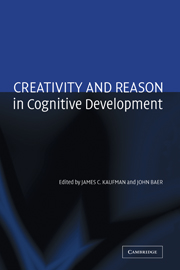Book contents
- Frontmatter
- Contents
- List of Contributors
- Acknowledgments
- Creativity and Reason in Cognitive Development
- Introduction
- COGNITIVE PERSPECTIVES
- 1 Expertise and Reason in Creative Thinking: Evidence from Case Studies and the Laboratory
- 2 Creative Genius, Knowledge, and Reason: The Lives and Works of Eminent Creators
- 3 Dynamic Processes Within Associative Memory Stores: Piecing Together the Neural Basis of Creative Cognition
- 4 The Creativity of Everyday Moral Reasoning: Empathy, Disgust, and Moral Persuasion
- 5 Reasoning and Personal Creativity
- 6 Alternative Knowledge Structures in Creative Thought: Schema, Associations, and Cases
- 7 The Role of the Knowledge Base in Creative Thinking
- 8 The Role of Domain Knowledge in Creative Problem Solving
- 9 Creative Thinking and Reasoning: Can You Have One Without the Other?
- 10 From Alexithymia, Borne of Trauma and Oppression, to Symbolic Elaboration, the Creative Expression of Emotions, and Rationality
- 11 Opening up Creativity: The Lenses of Axis and Focus
- DEVELOPMENTAL AND EDUCATIONAL PERSPECTIVES
- Author Index
- Subject Index
- References
9 - Creative Thinking and Reasoning: Can You Have One Without the Other?
Published online by Cambridge University Press: 19 January 2010
- Frontmatter
- Contents
- List of Contributors
- Acknowledgments
- Creativity and Reason in Cognitive Development
- Introduction
- COGNITIVE PERSPECTIVES
- 1 Expertise and Reason in Creative Thinking: Evidence from Case Studies and the Laboratory
- 2 Creative Genius, Knowledge, and Reason: The Lives and Works of Eminent Creators
- 3 Dynamic Processes Within Associative Memory Stores: Piecing Together the Neural Basis of Creative Cognition
- 4 The Creativity of Everyday Moral Reasoning: Empathy, Disgust, and Moral Persuasion
- 5 Reasoning and Personal Creativity
- 6 Alternative Knowledge Structures in Creative Thought: Schema, Associations, and Cases
- 7 The Role of the Knowledge Base in Creative Thinking
- 8 The Role of Domain Knowledge in Creative Problem Solving
- 9 Creative Thinking and Reasoning: Can You Have One Without the Other?
- 10 From Alexithymia, Borne of Trauma and Oppression, to Symbolic Elaboration, the Creative Expression of Emotions, and Rationality
- 11 Opening up Creativity: The Lenses of Axis and Focus
- DEVELOPMENTAL AND EDUCATIONAL PERSPECTIVES
- Author Index
- Subject Index
- References
Summary
There have been numerous demands in U.S. education for enhanced creative thinking and reasoning skills in our students. Unfortunately, there appears to be a dearth of research regarding the relationship between creative thinking and reasoning. Interestingly, Marzano (1998) reported that Goal 3 of The National Educational Goals Report: Building a Nation of Learners (National Education Goals Panel, 1991) addressed the improvement of thinking and reasoning skills. It is suggested, though, that creative thinking and reasoning are essential skills for student achievement and, ultimately, success in school. The purpose of this chapter, then, is to examine the relationship between creative thinking and reasoning. The chapter begins with a discussion of reasoning. This is followed by a discussion of creativity/creative thinking. Next is a discussion of research related to creative thinking and reasoning. Last, the chapter concludes with a discussion of the implications to research and practice.
REASONING
There are many definitions of reasoning. For the purpose of this chapter, reasoning is defined as “ … a deliberating process of working things out to solve problems …” (Calne, 1999, p. 18). As Calne noted, it may be perceived as a tool. However, he felt that reason does not have the ability to motivate because it has no affective component, which is required for one to attain any “mental rewards” (p. 27).
Interestingly, it was Inhelder and Piaget (1958) who first stipulated that there was an invariant sequence of stages of cognitive development that influenced mental/intellectual reasoning.
- Type
- Chapter
- Information
- Creativity and Reason in Cognitive Development , pp. 159 - 176Publisher: Cambridge University PressPrint publication year: 2006
References
- 8
- Cited by



